No health without mental health
As we all are aware of the havoc and chaos created by COVID-19 when it gripped over the whole world, it created a lot of stress and anxiety in my life too. Being indoors all the time during the first gloomy lockdown phase, managing two kids at home, one being an infant and with no help from the maid added to this strain of mine. Then a great, so-called calamity struck me, I suddenly started getting high-grade fever and developed chicken pox. While recovering from this debilitating chickenpox, I developed a chest infection with persistent cough and expectoration and this developed a fear and doubt in my mind as to whether this was Covid. Later after 15 days, both my kids got infected with chicken pox. This was like a vicious circle during this period of uncertainty. The environment outside was so scary, we were residing in Mumbai then. The city of dreams which never sleeps had come to a standstill. The streets which used to be always busy with traffic and people, wore an abandoned look. Whenever a single covid positive case was found, the entire building and the surrounding roads were being sealed. It was like a nightmare that caused a mental turmoil in my head and to worsen it was the depressing daily news headlines flashing on the television. Due to this unforgetful phase of my life, I chose to write on this topic of mental health. Recently 10th October was celebrated as world mental health day.
WHO defines ‘mental health as a state of well-being in which every individual realizes his or her own potential, can cope with the normal stresses of life, can work productively and fruitfully, and is able to make a contribution to her or his community.’ It regulates how we handle stress, relate to others, and make selections. Mental health is vital at every stage of life, from childhood and adolescence through adulthood. Everyone has a right to mental health and everyone deserves the chance to live. Mental health needs to be seen as an important section of health. Its lack is a great burden to the economic, social and political functioning of the country and it’s a vital resource for nations advancement.
Mental health and illness are determined by many social, psychological and biological factors. People who are exposed to unfavorable conditions – including poverty, violence and inequality – are at a greater risk of undergoing mental health conditions. Almost about one out of eight people in the world live with a mental disorder. Close to 15% of the world’s working population is projected to experience a mental disorder at any given time. Worldwide over, there may be 20 suicide attempts to every one death, and yet suicide accounts for more than one in every 100 deaths. It is the main cause of death among young people. Mental disorders are the important cause of years lived with disability (YLDs), accounting for one in every six YLDs globally. (World mental health report: transforming mental health for all. Geneva: World Health Organization; 2022)
The Global Burden of Disease 2020 projected that the COVID-19 pandemic has led to a 27.6% rise in cases of major depressive disorder (MDD) and a 25.6% rise in cases of anxiety disorders (AD) globally in 2020. In general, the pandemic was projected to have caused 137.1 additional disability-adjusted life years (DALYs) per 100 000 population for MDD and 116.1 per 100 000 population for AD. ( Global prevalence and burden of depressive and anxiety disorders in 204 countries and territories in 2020 due to the COVID-19 pandemic.)
Three new systematic reviews examined the wider psychological impact of the COVID-19 pandemic on the general public around the world. Luo, Guo, Yu, Jiang, and Wang (2020) showed a pooled prevalence of anxiety as 32 and depression as 27%, among the general public. Similarly, Salari et al. (2020), found the pooled prevalence of stress, anxiety, and depression, as 29.6, 31.9, and 33.7% respectively. Vindegaard and Benros (2020) found increased levels of depressive and anxiety symptoms along with general mental health symptoms. Based on these findings, it was concluded that ‘the COVID-19 pandemic has caused a heavy psychological impact among medical workers and the general public and ‘it has not only raised concerns over general public health, but has also caused a number of psychological and mental disorders’
Robinson et al (2020) stated a small but statistically important overall rise in the mental health symptoms during March-April 2020 in the general population, compared with the pre-pandemic measures. This decreased over time and became non-significant by May-July 2020. Increases in symptoms of depression and mood disorders remained important over time in March–April 2020 and May–July 2020; but those for anxiety did not in March–April 2020 and May–July 2020 . Kunzler et al (2021) also found a moderate symptom rise in the general population for depression and a small but important increase in symptoms of anxiety. Prati & Mancini (2021) found that early implementation of public health and social measures in 2020 also led to a small but significant rise in symptoms of anxiety and depression in the general population.
Numerous issues stop people from looking for help for mental health conditions, including poor quality of facilities, low levels of health literacy in mental health, and stigma and discrimination. Mental health remains defamed, underfunded and with inadequate capacity in most countries, rich and poor. Less than 1% of governmental health resources in low-income countries (LIC) go towards mental health.
There are three chief reasons to invest in mental health: public health, human rights and socioeconomic development. Investing in mental health for all, advances public health. It can significantly decrease suffering and advance the health, quality of life, functioning and life expectancy of people with mental health conditions. Globally all over, people with mental health conditions are often excluded from the community life and deprived of their basic rights. Investing in mental health can empower social and economic development. Poor mental health puts a halt on the development by reducing efficiency, damaging social relationships and leading to poverty.
All nations need to enlarge their specialized workforce for mental health. At all stages of life, promotion and prevention are required to improve mental well-being and resilience to prevent the beginning of mental health conditions, and to drive down the need for mental health care.
Suicide prevention is of international importance, with a Sustainable Development Goal (SDG) target to reduce the suicide mortality rate by one third by 2030. To help nations reach this target, WHO has established the LIVE LIFE approach to suicide prevention, which prioritizes on four interventions: limiting access to the means of suicide; interacting with the media for responsible reporting on suicide; nurturing social and emotional life skills in adolescents; and early interference for anyone affected by suicidal behaviours. Prohibition of highly dangerous pesticides is a particularly cheap and cost–effective intervention.
Infancy, childhood and adolescence are ages of vulnerability in mental health. Nurturing, caregiving and helpful learning environments can be immensely protective of future mental health. On the other hand, hostile childhood experiences increase the risk of facing mental health conditions. Four key policies for reducing risks and increasing protective factors include: developing and implementing policies and laws that encourage and protect mental health; supporting caregivers to provide nurturing care; implementing school-based programmes, including anti-bullying interventions; and improving the quality of environments in communities. School-based social and emotional learning programmes are among the most active promotion policies for nations at all income levels.
Employers and governments have a responsibility to create more work openings for people with mental health conditions, and to promote and protect all people’s mental health at work. Community-based mental health care includes a network of interrelated services that includes: mental health services combined in general health care; community mental health services; and services that deliver mental health care in non-health.
By 2023, the WHO Special Initiative for Mental Health is aiming to increase treatment coverage for mental health conditions by ensuring access to mental health care for 100 million more people over its 5-year plan. In many ways, health system strengthening provides the basics for change in mental health by reorganization and scaling up of services and support. Key areas for action include: governance and leadership; finance; public awareness; and competencies for mental health care.
In short, firstly, we must spread the value and commitment we give to mental health as individuals, communities and governments.
Secondly, we must redesign the physical, social and economic features of environments – in homes, schools, workplaces and the wider community – to better guard mental health and avert mental health conditions.
Thirdly, we must toughen mental health care so that the full range of mental health needs is met through a community-based system of available, reasonable and quality services and support.
Campbell has been generating resources on suicide prevention, which is an area that appears to have gaps in research and promoting evidence-based mental-health approaches to address this complex subject. Please visit these resources to know more:
1. Suicide prevention and COVID-(https://doi.org/10.1111/appy.12482)
2. The effects of interventions preventing self-harm and suicide in children and adolescents: an overview of systematic reviews (https://doi.org/10.12688/f1000research.19506.2)
3. Comprehensive approaches to youth suicide prevention (doi:10.1111/appy.12484)
LIVE AND LET LIVE!
References:
Santomauro DF, Mantilla Herrera AM, Shadid J, Zheng P, Ashbaugh C, Pigott DM, et al. Global prevalence and burden of depressive and anxiety disorders in 204 countries and territories in 2020 due to the COVID-19 pandemic. Lancet. 2021;398(10312):1700–1712. Global prevalence and burden of depressive and anxiety disorders in 204 countries and territories in 2020 due to the COVID-19 pandemic – PubMed (nih.gov)
Luo, M., Guo, L., Yu, M., Jiang, W., & Wang, H. (2020). The psychological and mental impact of coronavirus disease 2019 (COVID-19) on medical staff and general public – A systematic review and meta-analysis. Psychiatry Research, 291, 113190. The psychological and mental impact of coronavirus disease 2019 (COVID-19) on medical staff and general public – A systematic review and meta-analysis – PubMed (nih.gov)
Salari, N., Hosseinian-Far, A., Jalali, R., Vaisi-Raygani, A., Rasoulpoor, S., Mohammadi, M., … Khaledi-Paveh, B. (2020). Prevalence of stress, anxiety, depression among the general population during the COVID-19 pandemic: A systematic review and meta-analysis. Globalization and Health, 16(1), 57. Prevalence of stress, anxiety, depression among the general population during the COVID-19 pandemic: a systematic review and meta-analysis – PubMed (nih.gov)
Vindegaard, N., & Benros, M. E. (2020). COVID-19 pandemic and mental health consequences: Systematic review of the current evidence. Brain, Behavior, and Immunity, 89, 531–542. COVID-19 pandemic and mental health consequences: Systematic review of the current evidence – PubMed (nih.gov)
Robinson E, Sutin AR, Daly M, Jones A. A systematic review and meta-analysis of longitudinal cohort studies comparing mental health before versus during the COVID-19 pandemic in 2020. J Affect Disord. 2022;296:567–576. A systematic review and meta-analysis of longitudinal cohort studies comparing mental health before versus during the COVID-19 pandemic in 2020 – PubMed (nih.gov)
Kunzler AM, Röthke N, Günthner L, Stoffers-Winterling J, Tüscher O, Coenen M, et al. Mental burden and its risk and protective factors during the early phase of the SARS-CoV-2 pandemic: systematic review and meta-analyses. Global Health. 2021;17(1):1–29. Mental burden and its risk and protective factors during the early phase of the SARS-CoV-2 pandemic: systematic review and meta-analyses – PubMed (nih.gov)
Prati G, Mancini AD. The psychological impact of COVID-19 pandemic lockdowns: a review and meta-analysis of longitudinal studies and natural experiments. Psychol Med. 2021; 51(2):201–211. The psychological impact of COVID-19 pandemic lockdowns: a review and meta-analysis of longitudinal studies and natural experiments – PubMed (nih.gov)
Ivbijaro, G., Kolkiewicz, L., Goldberg, D., N’jie, I. N. S., Edwards, T., Riba, M. B., Švab, I., Geller, J., & Enum, Y. (2021). Suicide prevention and COVID-19. Asia-Pacific Psychiatry, 13( 3), e12482. https://onlinelibrary.wiley.com/doi/10.1111/appy.12482
Morken, I. S., Dahlgren, A., Lunde, I., & Toven, S. (2019). suicide in children and adolescents: an overview of systematic. children, 1000, 890. https://f1000research.com/articles/8-890/v2
Pumariega, A. J. (2021). Comprehensive approaches to youth suicide prevention. Asia-Pacific Psychiatry. https://onlinelibrary.wiley.com/doi/10.1111/appy.12484




